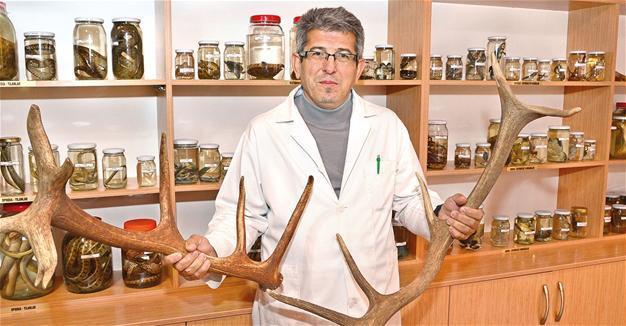Zoology Museum displays animals, serve academics
 A 4.5-meter-long python skin and two buckhorns, which have been seized in anti-smuggling operations by Turkish security officials, are being displayed at the Çanakkale Onsekiz Mart University (ÇOMU) Zoology Museum in the northwestern province of Çanakkale. Associate Professor Murat Tosunoğlu, a museum official and academic at the ÇOMU Biology Department, said that some specific animal species were being used in trade for various purposes. Tosunoğlu said there were shifts in the population of some endangered and protected animals.
A 4.5-meter-long python skin and two buckhorns, which have been seized in anti-smuggling operations by Turkish security officials, are being displayed at the Çanakkale Onsekiz Mart University (ÇOMU) Zoology Museum in the northwestern province of Çanakkale. Associate Professor Murat Tosunoğlu, a museum official and academic at the ÇOMU Biology Department, said that some specific animal species were being used in trade for various purposes. Tosunoğlu said there were shifts in the population of some endangered and protected animals. The Zoology Museum, which opened in March 2013, is home to more than 500 samples of 81 species ranging from birds to reptiles and from invertebrates to fish. He said that every piece found in the museum belonged to a living creature. “We keep the animals, which have been killed or have died naturally, here.
At the same time, all samples in the museum are used in academic works by national and international researchers. Another feature of the museum is that it displays some species that were seized in illegal actions.
Particularly, a 4.5 meter Asian python skin and two adult buckhorns, which were seized from smugglers, have drawn great interest from the museum’s visitors. It [python leather] is processed and tanned leather. It would be used to produce shoes, bags, wallets, belts and other personal products. We were informed about it and got in touch with relevant people to bring it to our museum. It is the longest remains of a species in our museum,” he added. The heaviest materials in the museum are from reptile species.
“These species are ignorantly killed or poisoned by people who think they are dangerous. Most of them are not dangerous and non-poisonous. The python leather in the museum is big enough to produce six to seven pairs of shoes and bags, belts and wallets. People should not buy products made out of leathers of such species,” he stressed. He also noted that two out of 90 buckhorns seized in antismuggling operations were being displayed in the museum, and added that by bringing them to the museum, their use in the production of beads and knives was prevented. “Visitors become aware when they learn what these pieces would have been used for if they had not been seized,” he added.
















